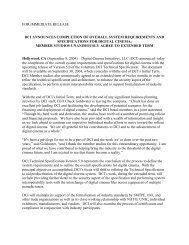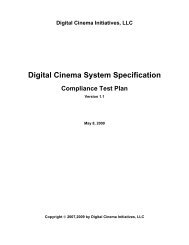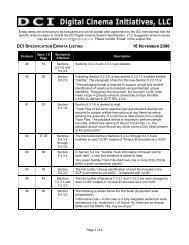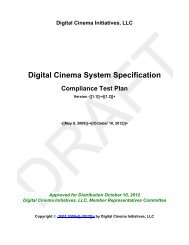DCI Specs - Digital Cinema Initiatives
DCI Specs - Digital Cinema Initiatives
DCI Specs - Digital Cinema Initiatives
Create successful ePaper yourself
Turn your PDF publications into a flip-book with our unique Google optimized e-Paper software.
7.5.2.2. Ingest InterfacesExcept for security messaging, the interfaces to the outside world can use any methodor physical connection. Inside the theater structure, the architecture is encouraged tobreak down into two types of interfaces, one for the content and one for control/statusand key exchange.• The content ingest interface is required to be Gigabit Ethernet [IEEE802.3ab(copper)] or [IEEE802.3z (fiber)] interface.• Theater facilities are required to provide a dial-up modem with a connectionthat will be available 24/7 for security communications (all ETM and log datareporting). It is theater management’s decision as to whether this connectionis dedicated. However it will be recognized that for some operationalsituations (e.g., receiving new KDMs), it may be important to have priorityaccess to this connection for security communications. Additional alternativemeans of security communication can be implemented by agreementbetween the parties.7.5.2.3. FirewallsTheater networks are required to protect the security system from the threat of externaland internal network-born attacks by the installation of appropriate firewalls. Becausethere will be many variations in network designs, it is impossible to define specificsolutions as part of this specification. Exhibition operators are encouraged to solicitcompetent network security engineering assistance as part of their facility networkdesign efforts.7.5.3. Storage7.5.3.1. IntroductionContent storage can be arranged into two basic configurations or a combination of thetwo. One is known as local storage and the other is central storage. Local storage is aconfiguration where the storage is located at each screen. Central storage is aconfiguration that has all of the storage of content in a central location for all of thescreens in a multiplex. There can also be combinations of central and local storage.7.5.3.2. Storage ReliabilityThe most important aspect of the storage system is reliability. There are a number ofRAID configurations that will provide storage redundancy and therefore storagereliability. The storage system is required to provide redundancy such that should asingle hard disc drive fail, the system will continue to play with no visible or audibleinterruptions or artifacts.7.5.3.3. Central StorageCentral Storage implies that packaged content for a multiplex may be stored in onelocation. Central Storage may allow for multicasting of the content.If only Central Storage architecture is used, careful planning is required to be done toensure that it does not have a single point of failure, including the network. In this type of<strong>DCI</strong> <strong>Digital</strong> <strong>Cinema</strong> System Specification v.1.2 Page 68
















